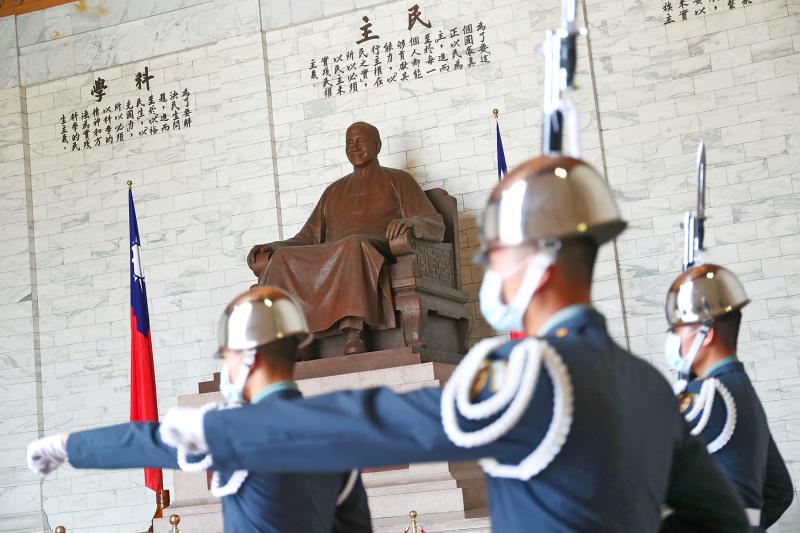The Transitional Justice Commission yesterday announced its plan for transforming Taipei’s Chiang Kai-shek Memorial Hall, which would prioritize removing the main hall’s large bronze statue of the former leader.
In today’s democratized society, all authoritarian character should be eradicated from the complex, which is itself a product of Taiwan’s authoritarian past, the commission said.
The most important task would be removing the hall’s “axis of worship,” or the 6.3m-tall bronze of Chiang Kai-shek (蔣介石) in its main chamber, it said.

Photo: CNA
Removing the statue — Taiwan’s largest remaining symbol of its authoritarian past — would indicate the “establishment of a liberal democratic constitutional order, denial of the legitimacy of authoritarian rule and remembrance of the historical lessons of human rights violations,” the commission said.
In its place, the proposal seeks to create a park for “reflection on Taiwan’s authoritarian history” by changing its function and appearance.
After the Chinese Nationalist Party’s (KMT) retreat to Taiwan, it invested significant resources into building the huge “memorial park” in the center of the nation’s capital.
Although ostensibly created to commemorate Chiang, the design and layout of the compound encourages visitors to worship rather than simply memorialize, the commission said.
For example, its flat, directional plaza leading up to the main hall with boundary walls surrounding the compound create lines of sight and pathways that suggest reverence of the central “temple,” it said.
The so-called “park” also has a huge amount of paved space which, despite being used by the public, retains its authoritarian character, since its spatial design and symbols have remained largely unchanged, it added.
The axis of worship should therefore be removed to reverse the spatial structure of the park, in addition to all of its accompanying authoritarian symbols, it said.
Yeh Hung-ling (葉虹靈), the commission’s acting minister, confirmed that the statue can legally be removed after consultation with the Ministry of Culture’s Bureau of Cultural Heritage.
While the hall is protected as a historical structure, the statue was not included in the registry, Yeh said, adding that any removal plan would require a review involving authorities in charge of heritage preservation.
As for what to do with the statue, Yeh said that a decision would be made after consulting with civil groups and victims of political persecution, although the common consensus is that retaining such a symbol in the center of the nation’s capital is problematic.
On the other hand, the reclaimed space offers endless possibilities, she said.
Some have proposed changing the main hall into an arts space, a memorial for past presidents or even a new location for the Legislative Yuan, she said, adding that the public could continue proposing ideas, although the two side halls would remain performance spaces.
Asked whether the Republic of China Honor Guard would be asked to leave the compound, Yeh said that a decision would need to be made by the Ministry of Culture, as it has jurisdiction over the hall.
Yeh also vowed to speed up the process, with plans to submit a full proposal to the Cabinet by next year.
Speaking to a party event, KMT Chairman Johnny Chiang (江啟臣) said yesterday that the person who should “reflect on authoritarianism” is the nation’s leader, referring to President Tsai Ing-wen (蔡英文) of the Democratic Progressive Party.
“She is not only an authoritarian leader over a one-party state, but also an admitted publicly elected dictator,” he said. “Does she not need to reflect on herself? Stepping down is better than tearing down statues.”
Additional reporting by Shih Hsiao-kuang

The US government has signed defense cooperation agreements with Japan and the Philippines to boost the deterrence capabilities of countries in the first island chain, a report by the National Security Bureau (NSB) showed. The main countries on the first island chain include the two nations and Taiwan. The bureau is to present the report at a meeting of the legislature’s Foreign Affairs and National Defense Committee tomorrow. The US military has deployed Typhon missile systems to Japan’s Yamaguchi Prefecture and Zambales province in the Philippines during their joint military exercises. It has also installed NMESIS anti-ship systems in Japan’s Okinawa

‘WIN-WIN’: The Philippines, and central and eastern European countries are important potential drone cooperation partners, Minister of Foreign Affairs Lin Chia-lung said Minister of Foreign Affairs Lin Chia-lung (林佳龍) in an interview published yesterday confirmed that there are joint ventures between Taiwan and Poland in the drone industry. Lin made the remark in an exclusive interview with the Chinese-language Liberty Times (the Taipei Times’ sister paper). The government-backed Taiwan Excellence Drone International Business Opportunities Alliance and the Polish Chamber of Unmanned Systems on Wednesday last week signed a memorandum of understanding in Poland to develop a “non-China” supply chain for drones and work together on key technologies. Asked if Taiwan prioritized Poland among central and eastern European countries in drone collaboration, Lin

BACK TO WORK? Prosecutors said they are considering filing an appeal, while the Hsinchu City Government said it has applied for Ann Kao’s reinstatement as mayor The High Court yesterday found suspended Hsinchu mayor Ann Kao (高虹安) not guilty of embezzling assistant fees, reducing her sentence to six months in prison commutable to a fine from seven years and four months. The verdict acquitted Kao of the corruption charge, but found her guilty of causing a public official to commit document forgery. The High Prosecutors’ Office said it is reviewing the ruling and considering whether to file an appeal. The Taipei District Court in July last year sentenced Kao to seven years and four months in prison, along with a four-year deprivation of civil rights, for contravening the Anti-Corruption

NO CONFIDENCE MOTION? The premier said that being toppled by the legislature for defending the Constitution would be a democratic badge of honor for him Premier Cho Jung-tai (卓榮泰) yesterday announced that the Cabinet would not countersign the amendments to the local revenue-sharing law passed by the Legislative Yuan last month. Cho said the decision not to countersign the amendments to the Act Governing the Allocation of Government Revenues and Expenditures (財政收支劃分法) was made in accordance with the Constitution. “The decision aims to safeguard our Constitution,” he said. The Constitution stipulates the president shall, in accordance with law, promulgate laws and issue mandates with the countersignature of the head of the Executive Yuan, or with the countersignatures of both the head of the Executive Yuan and ministers or